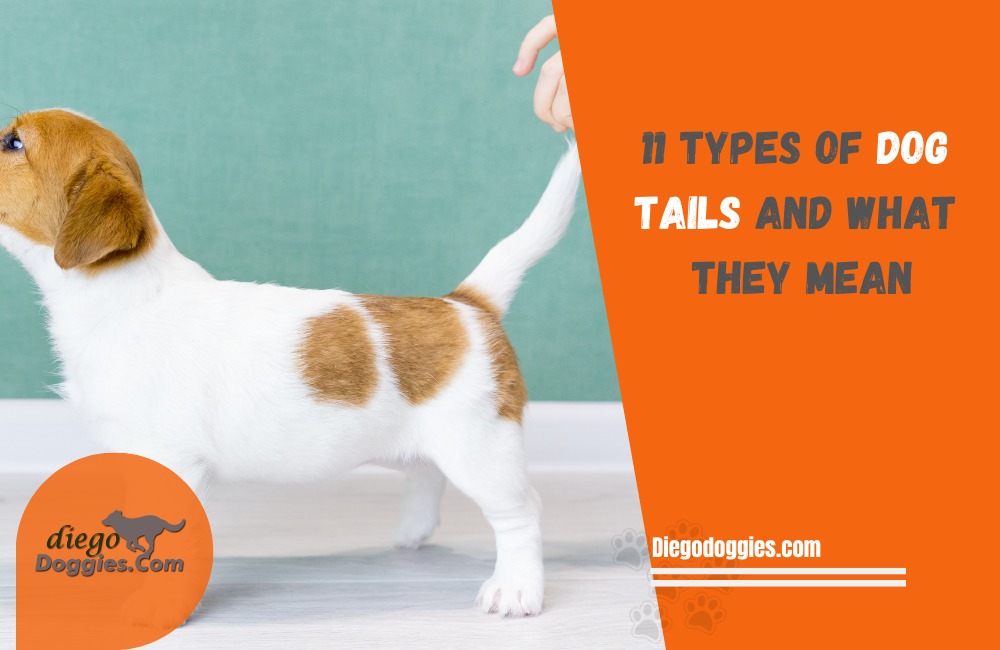Dogs are known for their wagging tails. But did you know that there are different types of dog tails and each one means something different? In this blog post, we will discuss the 11 types of dog tails and what they mean.
There are a few different types of tails, but the most common is the scared tail. This is when your dog’s tail is between its legs, and they look scared. This usually happens when they are in a new or unfamiliar situation. If you see this type of tail, it’s best to give your pup some space until they feel more comfortable.
From the happy wag to the scared tail, we will cover them all! So, if you want to know what your dog is trying to tell you, keep reading!
1. Happy Wag
The first type of tail is the happy wag. This is when your dog is wagging their tail from side to side, and they are usually in a good mood. They may be excited to see you, or they may just be happy in general.
2. Scared Tail
The second type of tail is the scared tail. This is when your dog’s tail is between their legs, and they look scared. This usually happens when they are in a new or unfamiliar situation.

3. Excited Tail
The third type of tail is the excited tail. This is when your dog’s tail is wagging so hard that its whole body is shaking! They may be excited to go for a walk or to see their favorite person.
4. Playful Tail
The fourth type of tail is the playful tail. This is when your dog’s tail is wagging from side to side, but they are not in a good mood. They may be trying to play with you, or they may be feeling mischievous.
5. Bored Tail
The fifth type of tail is the boring tail. This is when your dog’s tail is hanging down and they look like they are not interested in anything. They may be bored with their current situation, or they may just need more exercise.
6. Alert Tail
The sixth type of tail is the alert tail. This is when your dog’s tail is up, and they are looking around. They may be alerted by the noise, or they may be trying to protect you.
7. Dominant Tail
The seventh type of tail is the dominant tail. This is when your dog’s tail is up, and they are walking with confidence. They may be trying to show their dominance over another dog, or they may just be feeling confident.
8. Submissive Tail
The eighth type of tail is the submissive tail. This is when your dog’s tail is between their legs, and they are walking with its head down. They may be trying to show submission to another dog, or they may just be feeling scared.
9. Anxious Tail
The ninth type of tail is the anxious tail. This is when your dog’s tail is wagging from side to side, and they look like they are about to run away. They may be feeling anxious about something, or they may just need more exercise.

10. Aggressive Tail
The tenth type of tail is the aggressive tail. This is when your dog’s tail is up, and they are growling or barking. They may be feeling aggressive towards another dog or person.
11. Painful Tail
The eleventh type of tail is the painful tail. This is when your dog’s tail is hanging down and they are not moving it. This usually happens when they are in pain or if they have an injury.
Conclusion
There are many types of dog tails out there, and each one has a different meaning. By understanding the different types of tails, you can better communicate with your dog and understand what they’re trying to tell you.
Now that you know the different types of dog tails, you will be able to better understand what your dog is trying to tell you! If you are ever unsure, just ask your veterinarian for help.
Related Contents
- How to Stop a Puppy from Biting You
- How to Stop Your Dog from Being Aggressive To Strangers
- How to Teach a Dog to Smile: Fun and Easy Tips
- How to Train a Big Dog: Tips for Effective Obedience Training
- How to Train Your Dog to Roll Over in 7 Easy Steps
- Important Essential Training Tools for Dogs
- Running Safely With A Dog
- San Diego Dog Park Safety Tips, Training, and Dog Accessories
- Seven Top Tips: How to Train Your Dog to Hunt
- 14 Basic Dog Obedience Training Commands for Dogs
- 14 Easy Ways to Exercise Your Dog: Fun and Effective Methods
- 8 Therapy Dog Training Tips: How to Train Your Dog
- Choosing The Best Training Treats For Your Puppy


5 thoughts on “11 Types of Dog Tails and What They Mean”